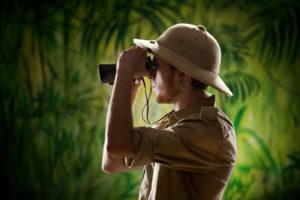You’ve heard it before: “As a trial attorney, you should be a Guide to the jury, mapping out a path to the evidence and showing the jury how it can find in favor of your client.”
But, is being a good “Guide” enough to get you to the finish line with the verdict you want?
It’s true that jurors appreciate a well guided path to the evidence. They like when attorneys map out a route, promising evidence in an Opening Statement and then fulfilling that promise during the trial itself.
What makes a case compelling to the jury, though, is when you act not only as “Guide”, but also as “Explorer.”
The Trial Attorney Explorer
When you act as an Explorer while trying your case to a jury, you are creating opportunities for the jury to DISCOVER and understand the case alongside you — instead of your just giving them a tour of the evidence.
Even though you are likely to know the close-up details of every piece of testimony or documentary evidence in a case, it’s important to present some of the evidence as if you are exploring it and learning about it with the jurors.
When I coach individual attorneys on improving their courtroom presence, I am often asked if this approach to examining evidence is like acting — in the phony sense. Jurors, as you probably know, are often skeptical of attorneys, and spot phoniness very quickly.
Taking on the role of Explorer doesn’t mean that you have to feign surprise each time a piece of evidence is discussed or a witness testifies. But it does mean that you uncover important pieces of evidence and testimony — as you explore the case with your jury. It also means that you review and present the evidence in such a way so as not to appear that you know everything, all the time, right from the get-go.
Trial Techniques for Letting the Jury See Your Inner Explorer
There are many techniques to transforming yourself from Guide to Explorer. Here are a few of the most important ones.
1. Throughout the trial, behave as if you are an Explorer.
- Listen carefully when witnesses testify– as opposed to looking at your notes for the next question.
- Be vigilant – read documents handed to you carefully, and parse words with witnesses where necessary.
- Never appear to be bored with any evidence or testimony, even if you know it inside and out.
- Look for nuances in witness behavior and explore them as they occur.
- Highlight moments periodically to emphasize your curiosity about the evidence and how it fits.
2. Plan to present at least a few important details that are not revealed in your Opening Statement.
One of the most best ways to create a compelling case is not to give it all away in advance.
Is there a “smoking gun” piece of evidence or testimony that you’re sure will come in? Don’t be so quick to tell the jurors about it in advance. Let them experience the admission of the evidence and its effect on the case in real time.
3. When focusing on important evidentiary details, don’t go straight to where the treasure is buried.

If you’re presenting documents electronically, for instance, start with the largest view of the document and progressively drill down into the document until you find the golden nugget with the jurors. Let jurors see you actually select an electronic annotation tool on the screen (like the highlighter) and watch you move it to the document to highlight the important detail — instead of your just displaying the page with the highlighted portion already in place.
And once you have found the buried treasure, map it back out in your Closing Argument:
“Ladies and Gentleman, when you’re reviewing the evidence, go back to Exhibit 3, on Page 5, on Paragraph 3, on the third line, you’ll see the two words that …”
There are plenty of ways to make sure jurors note and later remember important details like this (for many other examples, check out my recent post about making sure that jurors take the right notes).
These are just a few examples of how you can approach your case, with an eye toward creating the opportunity for jurors to become more interested in your presentation. By transitioning from Guide to Explorer, you’ll also transform the jurors into searchers, listeners, detectives, archaeologists, and uncoverers of the truth. This makes for a more active and compelling juror experience and may well be reflected in your verdict.
Now, go find a jury and explore your case.
–Larry


